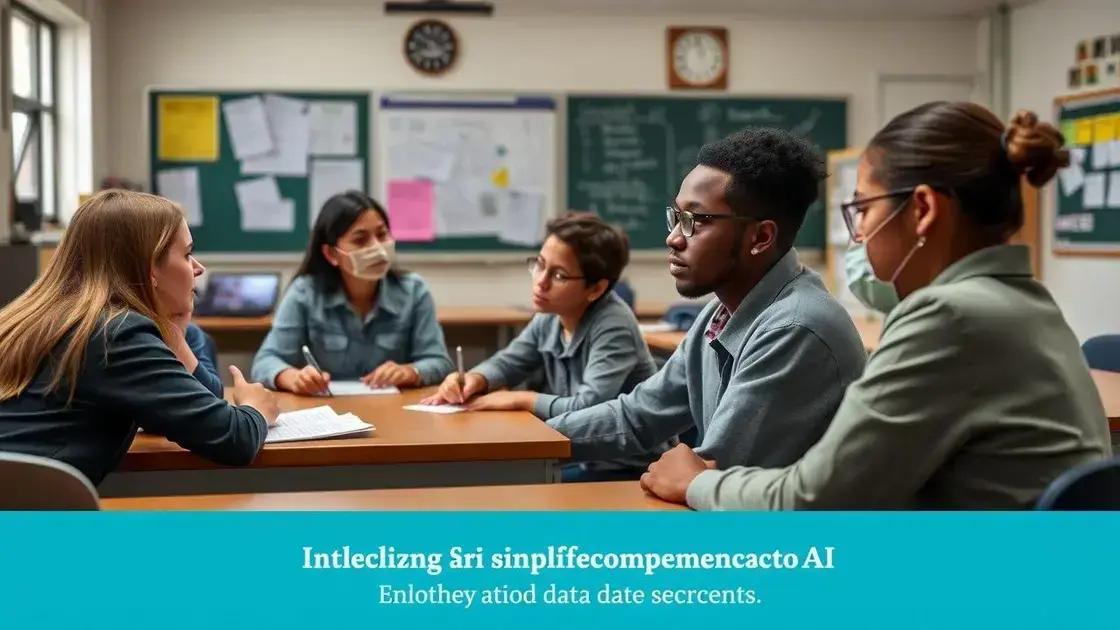K-12 AI integration: transforming education for the future

Anúncios
AI integration in K-12 education personalizes learning experiences, enhances engagement, and requires collaboration among educators, parents, and policymakers to effectively utilize technology and address challenges.
K-12 AI integration is becoming a crucial part of modern education, offering innovative tools that enhance learning experiences. Have you considered how these technologies could change the classroom dynamics?
Anúncios
Understanding K-12 AI integration
Understanding K-12 AI integration is vital for educators and students alike. This integration means using artificial intelligence tools and resources to enhance the learning experience. Imagine a classroom where teachers have AI assistants that help personalize lessons based on each student’s unique needs.
The advantages of K-12 AI integration
By adopting AI in schools, educators can improve engagement and learning outcomes. Students benefit from tailored learning paths, while teachers receive data-driven insights to track progress effectively.
Anúncios
- Personalized learning experiences
- Efficient administrative tasks for teachers
- Enhanced student engagement through interactive tools
- Data analysis to identify learning gaps
This technology can also address challenges faced in traditional teaching methods. AI tools can give instant feedback to students, allowing them to learn at their own pace. While not a replacement for a teacher, AI enhances the overall educational landscape.
How AI affects various subjects
In subjects like math and science, AI can offer simulations and real-time problem solving. This allows students to visualize concepts, making them easier to grasp. Furthermore, in language arts, AI tools can assist students with writing by providing grammar checks and style suggestions.
- Interactive math problems with instant solutions
- Science simulations for better comprehension
- Writing aids that enhance creativity
As K-12 AI integration continues to evolve, the education sector can look forward to innovative ways to improve learning. By embracing this technology, schools can prepare students for a future where technological fluency is crucial.
Key benefits of using AI in education
Using AI in education brings numerous benefits that can change the way students learn. With AI, teachers can provide personalized experiences that cater to each student’s needs. This makes learning more engaging and effective.
Improved student engagement
AI tools can make lessons more interactive. For instance, gamified learning platforms encourage students to participate more actively. They allow students to explore concepts in a fun way, leading to better retention of information.
- Gamification enhances motivation
- Interactive simulations for deeper understanding
- Instant feedback keeps students informed
Furthermore, AI can assist teachers with managing classroom activities efficiently. Automated administrative tasks mean that educators can focus more on teaching and less on paperwork. Tools like grade analyzers help in identifying students who need extra help.
Personalized learning experiences
With AI, students receive tailored support that aligns with their learning styles. This individualized approach allows them to progress at their own pace. When a student struggles with a topic, AI can suggest resources and activities that target those specific challenges.
- Adaptive learning platforms for varied paces
- Customized quizzes and assessments to challenge students
- Access to additional resources based on skill levels
The use of AI can also facilitate collaboration among students. Group projects can be enhanced through tools that help organize and streamline communication. This not only encourages teamwork but also builds essential skills like problem-solving.
As AI continues to integrate into educational settings, its potential to enhance learning experiences becomes clearer. With ongoing advancements, the benefits of using AI will only grow, paving the way for a new era in education.
Real-world examples of K-12 AI applications
There are many exciting real-world examples of K-12 AI applications that showcase how technology is changing education. Schools are beginning to utilize AI tools to enhance teaching and learning in meaningful ways. These applications are making education more interactive and personalized for students.
AI tutoring systems
One of the main ways AI is being used in classrooms is through online tutoring systems. These systems provide students with extra help outside of class. They can assess each student’s understanding of the material and adapt their methods accordingly.
- Example: Platforms like DreamBox Learning offer personalized math instruction.
- Example: Carnegie Learning provides AI-driven feedback on writing assignments.
- Example: Smart Sparrow allows teachers to create adaptive learning experiences.
Additionally, AI can help in identifying students who may need additional support. By analyzing performance data, teachers can intervene early and provide targeted assistance to keep students on track.
Virtual environments and simulations
Another fascinating example of K-12 AI applications is the use of virtual environments for science experiments or historical simulations. These experiences allow students to engage with complex concepts in an interactive way. Students can explore challenging subjects through virtual labs or role-playing scenarios.
- Example: Labster offers virtual lab experiences for biology and chemistry students.
- Example: Google Expeditions allows students to take virtual field trips to historical sites.
- Example: zSpace uses augmented reality to bring science lessons to life.
As schools recognize the power of AI, they are adopting these technologies to improve learning outcomes. The use of real-world applications not only enhances understanding but also prepares students for a future where technology will play a vital role in their careers.
Challenges in implementing AI in schools

While the integration of AI in schools offers many benefits, there are also notable challenges. Understanding these challenges is essential for educators and administrators. Addressing them can ensure a smoother implementation process.
Limited resources and funding
One significant challenge is the lack of financial resources. Often, schools and districts face budget constraints that limit their ability to invest in the necessary technology for AI implementation. Without adequate funding, acquiring advanced tools and training staff becomes a daunting task.
- Costs of hardware and software can be prohibitive.
- Ongoing maintenance and updates require additional budgeting.
- Professional development for teachers needs funding and resources.
Another issue is the unequal access to technology among schools. This digital divide can hinder efforts to implement AI solutions effectively across different districts.
Training and support for educators
For successful AI integration, teachers need proper training and support. Many educators may feel overwhelmed by new technologies and may lack the confidence to use AI tools effectively in their classrooms. Without adequate training programs, the full potential of these tools may not be utilized.
- Professional development opportunities can be limited.
- Teachers may resist adopting new technologies.
- Ongoing technical support is necessary for successful integration.
Additionally, educators may need time to adapt their curricula to incorporate AI tools seamlessly. Overcoming these human factors is essential for the overall success of AI in education.
There also exists a concern about data privacy and security. Schools must ensure that student information is protected while using AI tools, which means clear guidelines and secure systems must be in place to prevent data breaches.
Ultimately, understanding these challenges is crucial for creating effective strategies. By addressing funding issues, providing training opportunities, and ensuring data security, schools can navigate the complexities of AI implementation more effectively.
Future trends in AI for K-12 education
Future trends in AI for K-12 education are set to transform how students learn and how educators teach. As technology advances, several exciting developments are emerging that could reshape the educational landscape.
Increased personalization
One major trend is the growing emphasis on personalized learning. AI will enable software to analyze student performance in real-time, adjusting instruction to meet their individual needs. This means that each student can learn at their own pace, focusing on areas that require more attention.
- Adaptive learning algorithms to tailor content.
- Customized assignments based on student progress.
- Individual learning paths for each student.
This level of personalization helps in addressing diverse learning styles and abilities, ensuring that no student falls behind.
AI-driven assessment tools
Another significant trend is the use of AI-driven assessment tools that provide instant feedback to students. These tools will allow educators to gauge understanding more effectively. With real-time insights, teachers can identify which concepts need to be revisited and adjust their teaching strategies accordingly.
- Automated grading systems to save time.
- Data analytics to track student performance over time.
- Formative assessments that provide ongoing feedback.
In this way, AI tools are not just about making tasks easier but also enhancing the quality of education.
Collaboration tools powered by AI
Collaboration is another area where AI is making strides. Future applications will enable students to work together across distances, facilitating communication and teamwork. AI can help create collaborative environments by suggesting group members based on compatible skills and learning styles.
Furthermore, virtual classrooms will become more immersive with the integration of AI technologies, such as virtual reality and augmented reality. These tools can make lessons more interactive and engaging, allowing students to experience learning in new ways.
As we look ahead, the integration of AI into K-12 education will continue to evolve. With a focus on personalization, assessment, and collaboration, AI has the potential to unlock new opportunities for students and educators alike.
Tips for educators on adopting AI tools
Adopting AI tools in the classroom can be a game-changer for educators. However, it comes with its own set of challenges. Here are some practical tips to help educators smoothly integrate AI technology into their teaching.
Start with training and support
Before diving into AI, it’s essential for teachers to understand how these tools work. Schools should offer comprehensive training sessions that cover the basics of AI. This ensures that educators feel confident and are equipped to make the most of the technology.
- Provide hands-on workshops for teachers.
- Encourage peer mentoring among staff members.
- Develop online resources for continued learning.
Support is crucial as teachers may need assistance when using new tools. Having ongoing technical support can boost their comfort level with the technology.
Choose the right tools
When selecting AI tools, educators should consider their specific needs and the needs of their students. Not all tools are suitable for every classroom. It’s important to evaluate options based on functionality, user-friendliness, and relevance to the curriculum.
- Look for tools with proven efficacy in enhancing learning.
- Consider tools that offer customization to fit individual needs.
- Read reviews and gather feedback from other educators.
This thoughtful selection process can prevent frustration later and ensure that the tools used are genuinely beneficial.
Foster a culture of innovation
Creating an environment that embraces innovation can make a substantial difference. Educators should feel encouraged to experiment with AI tools. This involves being open to new ideas and not fearing failure when trying something new.
Sharing successes and challenges among peers can enhance learning and inspire others to adopt AI. Regular discussions about technology in staff meetings can foster a collective mindset towards innovation.
As teachers adapt to using AI tools, they will discover new ways to enhance student engagement and learning outcomes. The journey may have its hurdles, but with the right approach, it can lead to enriched classroom experiences.
How parents can support AI integration at home
Parents play a crucial role in supporting AI integration at home. By creating a conducive environment for learning, they help their children benefit from these new technologies. Here are some practical ways that parents can encourage this integration.
Encourage curiosity and exploration
One of the best ways parents can support their children’s interaction with AI tools is by fostering a sense of curiosity. Encourage kids to explore new educational apps or AI-driven tools. Asking questions about how these technologies work can spark their interest even more. Let them experiment and find what fascinates them.
- Introduce them to educational platforms that use AI.
- Explore coding games or robotics kits together.
- Discuss interesting AI-related topics from the news.
This supportive atmosphere can enhance their learning experience and help them understand the technology better.
Create a dedicated learning space
Having a designated space for learning is vital. Parents should set up a comfortable area with the necessary tools for their children to engage with AI technologies. This space should be free from distractions and equipped with a reliable internet connection and necessary devices.
- Ensure access to computers or tablets.
- Provide materials and resources for AI learning.
- Encourage a regular schedule for studying and exploring AI topics.
When children have an organized environment, they can focus better and make the most of the resources available to them.
Communicate with educators
Parents should maintain open lines of communication with teachers about how AI is being used in school. This can help parents align their support at home with what their children are learning at school. Understanding the tools being used allows parents to reinforce lessons through practice at home.
Additionally, parents can participate in school events focused on technology. These gatherings can provide insights into how AI is being integrated into the curriculum and how they can further support their children.
Ultimately, by embracing AI integration at home, parents can create an educational atmosphere that encourages their children to explore, learn, and adapt to the world of technology.
The role of policymakers in AI education

Policymakers play a critical role in shaping the landscape for AI education. Their decisions impact how technology is implemented in schools and how resources are allocated. Understanding their responsibilities is vital for the future of education.
Developing guidelines and standards
One major responsibility of policymakers is to establish clear guidelines and standards for the integration of AI in education. These standards ensure that schools use AI technologies safely and effectively. Guidelines can also help teachers understand how to incorporate AI tools into their lesson plans.
- Create frameworks that define acceptable AI usage in classrooms.
- Ensure that AI tools are designed for diverse learning needs.
- Promote transparency in AI algorithms used in education.
By providing robust guidelines, policymakers can foster a safe learning environment that maximizes the benefits of AI.
Funding and resource allocation
Another vital aspect of a policymaker’s role is distributing funds for educational technology. Policymakers must advocate for necessary budgets to purchase AI tools, provide training, and support research. Adequate funding helps schools implement AI solutions effectively.
- Secure grants for schools to adopt AI technologies.
- Support programs that provide training for educators.
- Encourage partnerships between schools and tech companies.
This financial support can ensure that all schools, regardless of location, have access to the latest AI advancements.
Monitoring and evaluation
Policymakers are also responsible for monitoring the implementation and impact of AI technologies in schools. Regular evaluation can help identify successful programs and areas that need improvement. Through data collection and analysis, policymakers can make informed decisions to enhance AI in education.
Setting up feedback mechanisms can help gather insights from teachers, students, and parents. This feedback is crucial for understanding the real-world impact of AI tools and for making necessary adjustments.
Overall, the role of policymakers in AI education extends beyond just making decisions. They must actively engage with educators and communities to create a framework that allows technology to thrive in educational settings.
The integration of AI in education presents both exciting opportunities and challenges. As schools begin to embrace AI tools, it’s essential for educators, parents, and policymakers to work together. By fostering a supportive environment for technology adoption, we can enhance learning experiences for all students. Together, we can build a future where AI empowers both teachers and learners, making education more personalized, engaging, and effective.
FAQ – Frequently Asked Questions about AI in Education
How can AI enhance student learning?
AI can provide personalized learning experiences, helping students learn at their own pace and improving their engagement with educational content.
What role do parents play in AI integration?
Parents can support AI integration by fostering curiosity, creating a dedicated learning space, and communicating with educators about the tools being used.
How can educators effectively use AI tools?
Educators can benefit from training, choosing the right tools that fit their classroom needs, and fostering a culture of innovation to experiment with new technologies.
What is the importance of policymakers in AI education?
Policymakers establish guidelines for AI use, allocate funding for technological resources, and monitor the effectiveness of AI tools in schools.






